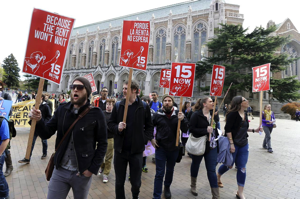
Econ-101: When a wage floor goes up, hours worked and employment go down.
It would be nice that if our legislators try and mess with the Law of Supply and Demand, that they have a little economic literacy first.
“If a politician wanted to make finding jobs harder for low-skilled workers, there’s nothing better than the minimum wage.”
Few ideas have been so thoroughly dismantled by reality as minimum-wage laws, which price some jobs out of existence and some workers out of jobs. Yet progressives keep expecting different results, and on Thursday Hillary Clinton endorsed a national increase. So let’s check in on the latest experiment: Seattle’s increase last year seems to be reducing employment.
That’s the finding of a new report by researchers at the University of Washington. The study compared nine months of 2015 in Seattle, where the wage is ticking up gradually and hit $13 an hour in January, with similar areas elsewhere in Washington. The authors produced a statistical model to figure out what Seattle would have looked like if the city’s planners hadn’t increased the wage floor.
The researchers found that the ordinance decreased the low-wage employment rate by about one-percentage point. Median wages went up for those who earned less than $11 an hour in 2014: to $11.14 at the end of 2015, from $9.96. Yet the study notes that only an estimated 73 cents of the increase is owed to the minimum wage.
The authors say much of the fillip is thanks to a strong economy, which is the best route to higher wages. The job growth rate in Seattle “tripled the national average between mid-2014 and late 2015.” This helps businesses absorb higher labor costs more easily than, say, Stockton, Calif., where unemployment is 8.3%. Yet nationwide labor-union campaigns like Fight For $15 would pound less prosperous areas of the country with zero regard to economic disparities.
Even so, Seattle’s uptick in hourly wages is offset by a reduction in employment and hours. The ordinance “modestly held back” employment of low-wage earners, and hours worked “lagged behind” regional trends, on average four hours each quarter (or 19 minutes a week). Many such individuals moved to take jobs outside the city at “an elevated rate compared to historical patterns,” says the report.
The progressive response is: So what? The effects are relatively small, and the report didn’t find evidence that businesses are failing at a higher rate. Yet the minimum wage will keep rising to $15 over the next two years (later for small businesses), and the authors predict the long-term consequences are “likely to be greater.” The business investment cycle is longer than a year, and one question is whether some employers—a fast-food franchisee, for example—will leave town when his lease ends.
None of this will surprise anyone who understands that increasing the cost of something will reduce the demand for it. Then again, that concept seems to elude both major presidential candidates, who have floated national minimum-wage increases. The results will be the same as in Seattle: Fewer opportunities for the people the law is intended to help.